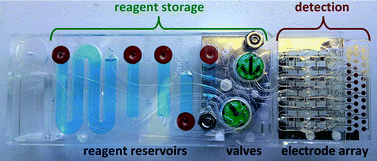Integrated microfluidic platform for the electrochemical detection of breast cancer markers in patient serum samples
Abstract
A microsystem integrating

* Corresponding authors
a
Nanobiotechnology and Bioanalysis Group, Departament d'Enginyeria Química, Universitat Rovira i Virgili, Avinguda Països Catalans, 26, Tarragona, Spain
E-mail:
alex.fragoso@urv.cat, ciara.osullivan@urv.cat
Fax: +34-977-889621
Tel: +34-977-558579
b Institut für Mikrotechnik Mainz, Carl Zeiss Strasse 18-20, Mainz, Germany
c Research Group Surgical Oncology, Charité Universitätsmedizin Berlin, Campus Buch, Lindenberger Weg 80, Berlin, Germany
d Microfluidic ChipShop GmbH, Carl Zeiss Promenade 10, Jena, Germany
e Institució Catalana de Recerca i Estudis Avançats, Passeig Lluís Companys 23, Barcelona, Spain
A microsystem integrating

 Please wait while we load your content...
Something went wrong. Try again?
Please wait while we load your content...
Something went wrong. Try again?
A. Fragoso, D. Latta, N. Laboria, F. von Germar, T. E. Hansen-Hagge, W. Kemmner, C. Gärtner, R. Klemm, K. S. Drese and C. K. O'Sullivan, Lab Chip, 2011, 11, 625 DOI: 10.1039/C0LC00398K
To request permission to reproduce material from this article, please go to the Copyright Clearance Center request page.
If you are an author contributing to an RSC publication, you do not need to request permission provided correct acknowledgement is given.
If you are the author of this article, you do not need to request permission to reproduce figures and diagrams provided correct acknowledgement is given. If you want to reproduce the whole article in a third-party publication (excluding your thesis/dissertation for which permission is not required) please go to the Copyright Clearance Center request page.
Read more about how to correctly acknowledge RSC content.
 Fetching data from CrossRef.
Fetching data from CrossRef.
This may take some time to load.
Loading related content
